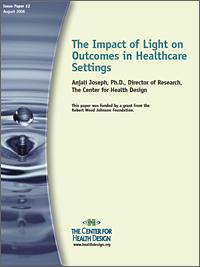Impact of Light on Outcomes in Healthcare Settings

Objective: To identify the mechanisms by which light impacts human health and performance and review the literature linking light (daylight and artificial light) with health outcomes in healthcare settings.
Methods: Literature review of peer-reviewed journal articles and research reports published in medicine, psychology, architecture, ergonomics, and lighting design periodicals and books. Keywords used to search for articles included light, lighting, daylight, sunlight, healthcare, hospitals, depression, circadian rhythm, health, patients and nurses.
Key findings: Light impacts human health and performance by enabling performance of visual tasks, controlling the body's circadian system, affecting mood and perception, and by enabling critical chemical reactions in the body. Studies show that higher light levels are linked with better performance of complex visual tasks and light requirements increase with age. By controlling the body's circadian system, light impacts outcomes in healthcare settings by reducing depression among patients, decreasing length of stay in hospitals, improving sleep and circadian rhythm, lessening agitation among dementia patients, easing pain, and improving adjustment to night-shift work among staff. The presence of windows in the workplace and access to daylight have been linked with increased satisfaction with the work environment. Further, exposure to light is critical for vitamin D metabolism in the human body. Light exposure also is used as a treatment for neonatal hyperbilirubinaemia.
Conclusions: Adequate and appropriate exposure to light is critical for health and well-being of patients as well as staff in healthcare settings. A combination of daylight and electric light can meet these needs. Natural light should be incorporated into lighting design in healthcare settings, not only because it is beneficial to patients and staff, but also because it is light delivered at no cost and in a form that most people prefer.


Add comment
Log in to post comments